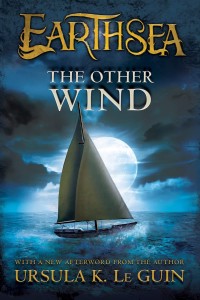
Ursula K. Le Guin’s conclusion to her fantastic Earthsea series. Once again, she manages to create a fantasy world where violence doesn’t solve everything. Her characters engage in the mundane activities that real people do most of the time: chat, make friends, think about their loved ones, cuddle with their pets, etc. The way she writes these mundane scenes makes them feel just as important and interesting as they really are.
Book 1: A Wizard Of Earthsea ⭐⭐⭐⭐⭐ Book 2: The Tombs Of Atuan ⭐⭐⭐▫️▫️ Book 3: The Farthest Shore ⭐⭐▫️▫️▫️ Book 4: Tehanu ⭐⭐⭐⭐▫️ Book 5: Tales From Earthsea ⭐⭐⭐▫️▫️ Book 6: The Other Wind ⭐⭐⭐⭐▫️ Book 7: The Books of Earthsea: The Complete Illustrated Edition ⭐⭐⭐▫️▫️
“The world’s vast and strange, Hara, but no vaster and no stranger than our minds are. Think of that sometimes.”
Hanging out with a friend or a loved one is one of the greatest things a human can do and yet how often do we see this honestly portrayed in fantasy? Yet, The Other Wind is the most “fantasy” fantasy book in the Earthsea series, featuring many tropes that you may have seen before (tropes: a restoration narrative, a mage haunted by his dark past, a king’s romance with a princess from another land, a conflict occurring on the edges of the known world, etc.) yet subverts or manages to make each of these tropes more interesting and grounded in reality than they would otherwise be if written by a less competent author.
“Maybe your gift will come back to you, when what must happen has happened. I cannot promise that. I will try to restore what I can of what I take from you. But we’re all walking in the night, now, on ground we don’t know. When the day comes we may know where we are, or we may not. […]”
As a conclusion to the Earthsea series, it succeeds in many ways. What I love about it most is how well Le Guin manages to do perspective shifting between the different POV characters, some new and some returning from previous books in the series.
In doing so, Le Guin manages to show us the characters we’ve been following through their journeys so far, where they’re at now and where they’re going as well as giving us the most comprehensive view on the inner workings of the world of Earthsea we’ve gotten in the series so far. It’s rare for a final book in a series to hit as hard as the first, The Other Wind got pretty close for me.
So, here in the center where earth’s powers met, the human powers had also met together: a king, a princess, the masters of wizardry.
And the dragons. And a priestess-thief turned farmwife, and a village sorcerer with a broken heart…
It’s a great conclusion to the series. Now that I’ve read the whole series I can confirm with certainty that the third book, The Farthest Shore, is not worth reading, unless you’re a super fan who needs to know just how bad it is. The Other Wind feels like Le Guin’s rerun of The Farthest Shore in more ways than one. Thankfully, The Other Wind succeeds where The Farthest Shore does not.